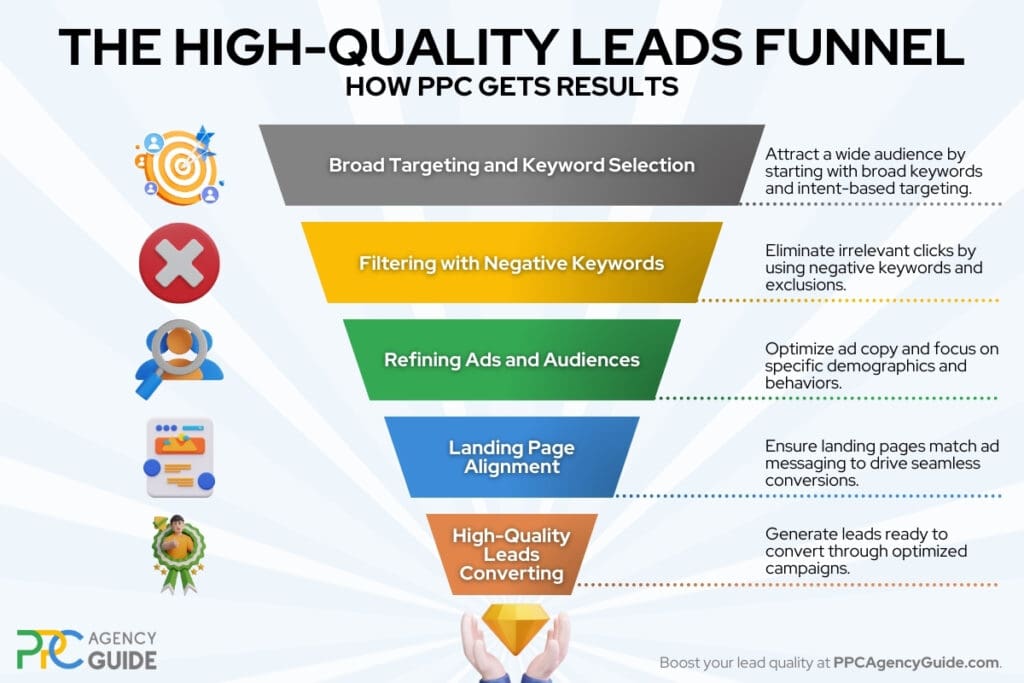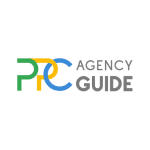
If you’ve ever run a pay-per-click (PPC) campaign only to end up with a pile of unqualified leads, you’re not alone. It’s a common frustration for businesses investing in paid ads. You set up what seems like a well-targeted campaign, watch the clicks roll in, and then… nothing. Leads that don’t convert. Contacts who don’t match your ideal customer profile. The wasted budget on irrelevant clicks. Sound familiar?
In addition to wasted money, low-quality leads result in wasted time and effort, too. They clog up your sales funnel and pull attention away from prospects who are actually ready to buy. The question many businesses ask is, “Are all PPC leads just junk?” The short answer is “No.” The problem isn’t PPC itself. It’s how the campaigns are managed.
When done right, PPC has the power to attract high-quality leads, those gems that can truly drive your business forward. The key lies in targeting, filtering, and optimizing your campaigns to focus on the right audience. In this guide, we’ll explore how to go from junk to gems by leveraging smart PPC strategies that ensure every click counts.
The Role of Targeting in High-Quality PPC Leads
When it comes to PPC campaigns, targeting is everything. The effectiveness of your ads depends on how well you pinpoint the audience that’s most likely to convert. Fail to target correctly, and you risk attracting the wrong clicks, which leads to wasted budget and, worse, wasted opportunities.
The beauty of PPC lies in its precision. Platforms like Google Ads and Facebook Ads offer advanced targeting capabilities that allow you to narrow down your audience with incredible accuracy. By leveraging these tools, you can ensure that your ads are reaching high-quality leads who match your ideal customer profile.
Targeting High-Quality Leads: The Essentials
- Define Your Audience: Start by creating detailed buyer personas. Who are your ideal customers? Consider factors like demographics, interests, job roles, and online behavior.
- Use Intent-Based Keywords: Focus on keywords that indicate clear purchasing intent. For example, someone searching for “affordable accounting software for small businesses” is much closer to converting than someone searching for “what is accounting software.”
- Layer Your Targeting: Take advantage of layered targeting options. For instance, combine demographic filters such as age, income level, and location with behavior-based targeting like search history and interests to zero in on the most relevant audience.
Advanced PPC Ad Targeting Strategies
- Custom Audiences: Upload a list of your existing customers or leads to create highly tailored campaigns targeting similar prospects.
- Lookalike Audiences: Use tools like Facebook’s Lookalike Audience feature to find new potential customers who share traits with your best-performing leads.
- Geotargeting: If location matters, refine your targeting to include or exclude specific areas, ensuring your budget is spent in the right places.
Filtering Low-Quality Leads Before They Click
Even the best-targeted campaigns can attract the occasional irrelevant click. That’s where filtering comes in. By actively excluding low-quality leads before they click on your ad, you can prevent wasted budget and ensure your campaigns focus on prospects who are more likely to convert.
Why Filtering Matters
Without proper filtering, your ads can appear to audiences who have no real intention of engaging with your product or service. For example, if you’re running PPC ads for a luxury service, clicks from users searching for “cheap” options are unlikely to result in a sale. These irrelevant clicks inflate your costs and hurt your campaign performance metrics, such as cost-per-lead (CPL) and conversion rates.
Using Negative Keywords in PPC
One of the most effective tools for filtering low-quality leads is the negative keyword list. Negative keywords tell ad platforms which search terms should not trigger your ads, helping you avoid mismatched intent.
How to Build a Strong Negative Keyword List
- Analyze Search Query Reports: Regularly review the search terms that triggered your ads. Identify terms that are irrelevant or attract the wrong audience, and add them to your negative keyword list.
- Exclude Low-Intent Keywords: Examples include terms like “free,” “cheap,” or “DIY,” if your product or service isn’t aligned with these expectations.
- Use Broad and Phrase Matches Carefully: While broad match keywords can help you cast a wide net, they often lead to irrelevant clicks. Add modifiers or negative keywords to refine your targeting.
Other Filtering Tactics
In addition to negative keywords, consider these strategies to filter out low-quality leads.
- Ad Scheduling: Run your ads during times when your target audience is most active to avoid irrelevant clicks.
- Device Targeting: Focus your ads on devices that align with your audience’s behavior. For instance, B2B campaigns may perform better on desktops than mobile devices.
- Audience Exclusions: Exclude audiences that don’t fit your buyer persona, such as certain age groups or geographic locations.
Optimizing PPC Ads for High Conversion Rates
Targeting and filtering are essential, but your work doesn’t stop there. Even if you reach the right audience, your PPC ads need to compel them to click and, more importantly, convert. Effective ad optimization ensures you’re attracting the most motivated prospects and guiding them seamlessly through the conversion process.
Crafting Ads That Pre-Qualify Clicks
One of the simplest ways to improve lead quality is to use your ad copy and visuals to set clear expectations. This helps ensure that the people clicking on your ads already align with your product or service.
- Be Specific About Who You’re Targeting: Include qualifiers in your headlines or descriptions. For example, “Solutions for Small Businesses Over $1M in Revenue” or “Premium Services for Discerning Homeowners.”
- Highlight Benefits Over Features: Focus on how your product or service solves problems or improves lives. For instance, instead of “Cloud Storage with 1TB Capacity,” try “Securely Store and Access Your Files Anytime, Anywhere.”
- Incorporate Strong Calls-to-Action (CTAs): Guide prospects toward the next step with actionable language. Examples include “Get Your Free Quote Today” and “Schedule a Demo to See the Results Yourself.”
Designing Landing Pages for Conversion
Your ad might grab their attention, but your landing page seals the deal. Misaligned or poorly designed landing pages are a common culprit behind low-quality leads.
- Match the Ad to the Page: Ensure the messaging, offer, and design of your landing page align perfectly with the ad that brought the user there. Consistency builds trust.
- Use Forms to Filter Leads: Longer forms with specific questions can help pre-qualify leads. For example, ask for details like company size, budget range, or location. This weeds out prospects who aren’t a good fit.
- Optimize for Speed and Clarity: Ensure your page loads quickly and is easy to navigate. Visitors won’t stick around if your page is slow or confusing.
Testing and Refining for Better Results
Optimization is never a one-and-done process. Regular testing and adjustments can help you improve lead quality over time.
- Run A/B Tests: Experiment with different headlines, visuals, CTAs, or even audience segments to see what works best.
- Monitor Key Metrics: Focus on metrics like bounce rate, time on page, and conversion rates to gauge how well your ads and landing pages are performing.
- Iterate Based on Data: Use insights from your tests to refine your campaigns. For instance, if one version of a landing page consistently attracts better leads, adopt those changes across other pages.

Measuring Lead Quality in PPC Campaigns
The success of a PPC campaign isn’t just about clicks—it’s about the quality of the leads those clicks generate. Without measuring lead quality, you’re left guessing whether your campaigns are truly delivering value. By tracking the right metrics and leveraging the right tools, you can evaluate your PPC efforts and make data-driven decisions to improve.
Key Metrics to Evaluate Lead Quality
- Conversion Rate: A high conversion rate is often a strong indicator of lead quality, but don’t stop there. Look at the actions users are taking after they convert. Are they downloading your whitepaper, booking a consultation, or completing a purchase?
- Cost Per Lead (CPL): Measure how much you’re spending to acquire each lead. A low CPL isn’t always a win if those leads aren’t converting into paying customers.
- Lead-to-Customer Ratio: Track how many leads move through your sales funnel and convert into customers. This is one of the clearest indicators of lead quality.
- Engagement Metrics: Beyond conversions, monitor how engaged your leads are with your business. Metrics like time on site, pages visited, and repeat visits provide valuable insights into lead intent.
Tools for Measuring Lead Quality in PPC
- Google Analytics: Set up conversion tracking to monitor actions like form submissions, downloads, or calls. Additionally, use UTM parameters to track specific campaigns and identify which are driving the most valuable traffic.
- CRM Software: Connect your PPC campaigns to your CRM to gain deeper insights into the lifecycle of a lead. Tools like HubSpot, Salesforce, or Zoho help track how leads interact with your business post-conversion.
- Google Ads Lead Form Extensions: Use these to capture lead information directly within the ad platform and analyze which campaigns deliver the most relevant data.
- Call Tracking Software: For businesses that rely on phone calls, platforms like CallRail or CallTrackingMetrics can help assess lead quality and link calls back to specific ads.
Continuous Improvement Through Data Analysis
- Monitor Trends Over Time: Track metrics monthly or quarterly to spot trends in lead quality. This helps you understand what’s working and where adjustments are needed.
- Compare Campaigns and Channels: Analyze lead quality across different PPC campaigns and advertising channels. For instance, Google Ads vs. LinkedIn Ads. Reallocate budgets to high-performing channels.
- Leverage Feedback from Sales Teams: Your sales team can offer real-world insights into lead quality. Incorporate their feedback to refine your targeting and messaging strategies.
Advanced Strategies to Improve PPC Lead Quality
Once you’ve mastered the basics of targeting and measuring lead quality, it’s time to take your PPC campaigns to the next level. Advanced strategies can help you refine your approach and focus your efforts on generating the highest-quality leads possible.
Retargeting Campaigns: Bring Back Interested Prospects
Retargeting allows you to reach users who’ve previously interacted with your website or ads but didn’t convert. These audiences have already shown interest, making them more likely to turn into qualified leads.
How to Implement Retargeting Effectively
- Segment Your Audience: Target users based on specific actions they’ve taken, such as visiting a product page or starting but not completing a form.
- Tailor Your Messaging: Use dynamic ads to personalize offers or highlight solutions that match the user’s previous behavior.
Lookalike Audiences: Scale Your Best Leads
Lookalike audiences help you find new prospects who share similar traits with your best-performing leads. By leveraging data from your existing customer base, you can target users who are more likely to convert.
How to Use Lookalike Audiences
Upload a list of high-quality leads or customers to your ad platform. Then, build a lookalike audience that closely matches their demographics, behaviors, and interests. Adjust the similarity threshold to balance reach and precision.
Intent-Based Targeting: Focus on Users Ready to Convert
Advanced PPC platforms allow you to target users based on intent signals, such as search behavior, purchasing patterns, or engagement with related content.
Tactics for Intent-Based Targeting
- In-Market Audiences: Use Google Ads’ in-market audience feature to target users actively researching products or services in your industry.
- Custom Intent Audiences: Build custom audiences by selecting keywords and URLs that align with high-converting prospects.
Fine-Tune Your Ad Scheduling and Device Targeting
Sometimes, it’s not just who you target but when and how. By analyzing past performance data, you can identify patterns in lead quality based on timing and device usage.
Tips for Optimization
- Ad Scheduling: Limit your ads to timeframes when high-quality leads are most active. For example, B2B campaigns may perform better during business hours.
- Device Targeting: Focus on devices that align with your audience’s behavior. If mobile users generate lower-quality leads, allocate more budget to desktop campaigns.
Use Exclusions to Narrow Your Focus
Exclusions are a powerful way to refine your targeting by eliminating segments that are unlikely to convert.
Examples of Exclusions
- Audience Exclusions: Remove irrelevant groups, such as current employees or users who’ve already converted.
- Placements: Exclude low-performing placements, like mobile apps or irrelevant websites.
Continuously Test and Adapt
Advanced strategies require continuous refinement. Regular testing and adjustments ensure your campaigns remain optimized for lead quality.
What to Test
- Content: Ad creatives, headlines, and offers.
- Targeting: New audience segments or exclusions.
- Bidding: Different bid strategies, such as manual CPC or target CPA.
Let an Experienced PPC Agency Take You from Junk to Gems
Turning low-quality leads into high-value opportunities isn’t easy. It takes expertise, advanced tools, and continuous optimization to ensure your PPC campaigns deliver the best results. That’s where an experienced PPC agency comes in. With the right partner, you can focus on running your business while the experts handle everything from targeting to testing, transforming your leads from junk to gems. We’re happy to match you with a trusted agency. To get started, request a complimentary consultation.

FAQs on the Impact of PPC on Lead Quality
How can I measure the quality of leads from my PPC campaigns?
Metrics like conversion rate, cost per lead (CPL), and lead-to-customer ratio can help gauge lead quality. Tools like Google Analytics and CRMs provide deeper insights into lead behavior.
What are negative keywords, and how do they help improve lead quality?
Negative keywords prevent your ads from showing for irrelevant search queries, helping you avoid clicks from users who are unlikely to convert.
Why do some PPC campaigns deliver low-quality leads?
Poor audience targeting, unclear ad copy, and misaligned landing pages are common reasons campaigns attract unqualified leads.
Can PPC campaigns work for B2B lead generation?
Absolutely. With precise targeting and tailored messaging, PPC campaigns can deliver high-quality B2B leads by focusing on decision-makers and intent-based searches.
How can I filter out low-quality leads in my PPC campaigns?
Using tools like negative keywords, audience exclusions, and tailored ad copy can help pre-qualify leads and reduce irrelevant clicks.
Do I need a PPC agency to improve lead quality?
While it’s possible to manage campaigns in-house, a PPC agency brings expertise, tools, and a data-driven approach that can significantly boost lead quality and ROI.


















